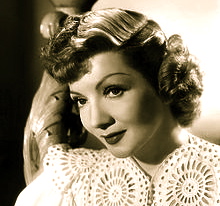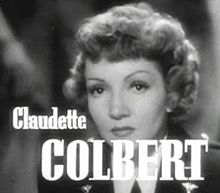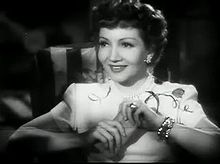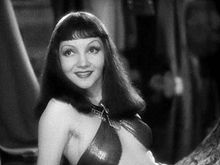Claudette Colbert

Claudette Colbert – Hello, My Darling
Claudette Colbert (/koʊlˈbɛər/; September 13, 1903 – July 30, 1996) was a French-born American actress of stage and film.
Raised in New York City, Colbert began her career in Broadway productions during the 1920s, progressing to film with the advent of talking pictures. She established a successful film career with Paramount Pictures, and is recognized as one of the leading female exponents of screwball comedy. Colbert was the highest paid actress in American cinema during late 1930s, and later became a freelance performer. She won the Academy Award for Best Actress for her comedic performance in It Happened One Night (1934), and also received Academy Award nominations for her dramatic roles in Private Worlds (1935) and Since You Went Away (1944).
Colbert’s film career declined in the 1950s, and she retired from film in 1961. She returned to the theater, with the occasional brief appearance on television. Her career spanned more than six decades. Late in life she moved to Barbados, where she died at the age of 92, following a series of strokes.
Colbert received theatre awards from the Sarah Siddons Society, a lifetime-achievement award at the Kennedy Center Honors, and, in 1999, the American Film Institute placed her at number twelve on their “AFI’s 100 Years… 100 Stars” list of the “50 Greatest American Screen Legends.”
Early life
 Commemorative plate on Colbert’s birthplace in Paris, France.
Commemorative plate on Colbert’s birthplace in Paris, France.
Émilie Chauchoin was born in Saint-Mandé, Seine, France, to Georges Claude, a banker and pastry cook, and Jeanne Marie Loew Chauchoin. Her father was of French ancestry and her mother of British. Despite being christened “Emilie”, she was called “Lily” as nickname because she had a cousin, the daughter of her mother’s sister, of the same name. After some financial reversals, her family emigrated to New York City in 1911. Her mother was a fluent English speaker so Colbert could quickly learn English.
Colbert studied at Washington Irving High School where her speech teacher, Alice Rossetter, encouraged her to audition for a play she had written. Colbert made her stage debut at the Provincetown Playhouse in The Widow’s Veil at the age of 15.
She attended the Art Students League of New York, intending to become a fashion designer, but appeared on the Broadway stage in a small role in The Wild Westcotts (1923). She had been using the name Claudette instead of nick name Lily since high school, and for her stage name she added her maternal grandmother’s maiden name, Colbert.
Career – From Broadway to Hollywood
After signing a five-year contract with the producer Al Woods, Colbert played ingenue roles on Broadway from 1925 through 1929. During her early years on stage, she fought against being typecast as a maid, and received critical acclaim on Broadway in the production of The Barker (1927), playing a carnival snake charmer. She later reprised this role for the play’s run in London’s West End. Colbert was noticed by the theatrical producer Leland Hayward, who suggested her for a role in Frank Capra‘s film For the Love of Mike (1927), now believed to be lost. The film, Colbert’s only silent film role, was a box office failure.
Colbert continued her stage career, but ultimately signed a contract with Paramount Pictures in 1928. Her first sound film was The Hole in the Wall (1929), co-starring Edward G. Robinson. During production of her second sound film, The Lady Lies (also in 1929), Colbert was appearing nightly in the play See Naples and Die. Her then two plays, Eugene O’Neill‘s Dynamo and See Naples and Die (1929), were unsuccessful. Her earliest films were produced in New York. In 1930 she was cast in The Big Pond, which was filmed in both English and French, and Colbert’s fluency in both languages. She appeared opposite Maurice Chevalier, who commented of her, “She was lovely, brunette, talented and a delicious comedienne, and her English was perfect.” While these films were popular with audiences, one of her films from this period, Young Man of Manhattan, her only collaboration with her first husband, Norman Foster, received negative notices. The magazine Picturegoer criticized Foster’s performance and noted him as one of Colbert’s weakest leading men, writing, “He did not seem to get any sincerity into his love scenes.” She also appeared inMysterious Mr. Parkes, which was a French-language version of Slightly Scarlet for the European market, although it was also screened in the United States.
She co-starred with Fredric March in Manslaughter (1930), and received good reviews for her performance as a rich girl, jailed for vehicular manslaughter. The New York Times wrote that she is capable of excellent acting. She was briefly paired with March, and they made four films together, including Dorothy Arzner‘s Honor Among Lovers (1931). She sang in her role opposite Maurice Chevalier in the Ernst Lubitsch musical The Smiling Lieutenant (1931), and was admired by critics for her ability to shrewdly play character role opposite the Miriam Hopkins.
In Cleopatra (1934)
Colbert was cast as a femme fatale in Cecil B. DeMille‘s films where she wears fetishistic costumes which lose another layer of clothing. In the 1932 historical epic, The Sign of the Cross, she was cast opposite Fredric March as the Roman empress Poppaea. For an instant, glimpses of her bare breasts and nipples were visible in a scene where her character was bathing in asses’ milk, a scene that came to be regarded as an example of Hollywood decadence prior to the enforcement of the Production Code. In 1933, Colbert renegotiated her contract with Paramount to allow her to appear in films for other studios. In Cleopatra (1934), she played the title role opposite Warren William. Thereafter, Colbert did not wish to be portrayed as overtly sexual and later refused such roles.
Breakthrough
 Colbert shows co-star Clark Gable how to hitchhike in It Happened One Night (1934)
Colbert shows co-star Clark Gable how to hitchhike in It Happened One Night (1934)
Colbert was reluctant to appear as the “runaway heiress”, Ellie Andrews, in the Frank Capra romantic comedy, It Happened One Night (1934), opposite Clark Gable and released by Columbia Pictures. Behind schedule after several actresses had refused the role, the studio accepted Colbert’s demand that she be paid $50,000 and that filming was to be completed within four weeks to allow her to take a planned vacation. Through the filming, Colbert felt that the script was weak, and Capra claimed, Colbert “had many little tantrums, motivated by her antipathy toward me,” however “she was wonderful in the part.”
After filming was completed, Colbert complained to her friend, “I just finished the worst picture in the world.” Capra fretted that the film was released to indifferent reviews and initially only did so-so business. Then, after it was released to the secondary movie houses, word-of-mouth began to spread and tickets sales became brisk. It turned out to be a major hit, easily Columbia’s biggest hit to date.
The film contained at least one scene that is often cited as representative of the screwball film genre and which became well known, being a resounding box-office success. In 1935, after her Academy Award nomination, Colbert decided not to attend the presentation, feeling confident that she would not win the award, and instead, planned to take a cross-country railroad trip. After she was named the winner, studio chief Harry Cohn sent someone to “drag her off” the train, which had not yet left the station, and take her to the ceremony. Colbert arrived wearing a two-piece traveling suit which she had the Paramount Pictures costume designer, Travis Banton, make for her trip.
 In Cleopatra (1934)
In Cleopatra (1934)
Colbert’s success allowed her to renegotiate her contract, raising her salary. In 1935 and 1936, she was listed in the annual “Quigley Poll of the Top Ten Money Making Stars”, which was compiled from the votes of movie exhibitors throughout the U.S. for the stars who had generated the most revenue in their theaters over the previous year. She received a second Academy Award nomination for her role in the hospital drama, Private Worlds (1935).
In 1936, Colbert signed a new contract with Paramount Pictures, which required her to make seven films over a two-year period, and this contract made her Hollywood’s highest paid actress. This was followed by a contract renewal in 1938, after which she was reported to be the highest paid performer in Hollywood with a salary of $426,924.
Colbert was a stickler for regarding the way she appeared on screen. She believed that her face was difficult to light and photograph, and she was obsessed with not showing right side of her face, to the camera, because of a small bump that resulted from a childhood broken nose. She refused to be filmed from right side of her face, and it often necessitated redesigning movie sets. She learned about lighting and cinematography, and refused to begin filming until she was satisfied that she would be shown to her best advantage. One example of Colbert’s determination to control the way she was photographed occurred during the filming of Tovarich in 1937, when one of her favored cameramen was dismissed by the director, Anatole Litvak. After seeing the rushes filmed by the replacement, Colbert refused to continue. She insisted on hiring her own cameraman, and offered to waive her salary if the film went over budget as a result. Drums Along the Mohawk (1939) with Henry Fonda was Colbert’s first color film. However, she distrusted the relatively new Technicolor process and feared that she would not photograph well, preferring thereafter to be filmed in black and white.
At the peak of her popularity in the late 1930s, Colbert earned $150,000 a film.
During this time she began acting for CBS‘ popular Lux Radio Theater, making 22 appearances between 1935 and 1954.
Continued success
 In So Proudly We Hail! (1943)
In So Proudly We Hail! (1943)
In 1940, Colbert refused a seven-year contract that would have paid her $200,000 a year, as she had found that she could command a fee of $150,000 per film as a freelance artist. With her brother as her manager, Colbert was able to secure roles in prestigious films, and this period marked the height of her earning ability.
During filming of So Proudly We Hail! (1943), a rift occurred between Colbert and co-starr Paulette Goddard. Asked which of her costars she preferred, Goddard had replied, “Veronica (Lake), I think.”. Goddard further commented that Colbert “flipped” and “was at Paulette’s eyes at every moment,” and said that they continued their feud throughout the duration of filming.
Impressed by her performance in this film, but aware of Colbert’s sensitivity, David O. Selznick approached her to play the lead role in Since You Went Away (1944). She was initially reluctant to appear as mother of teenaged children, but Selznick admired her marketability. The director, John Cromwell, later noted that Colbert was very professional, but Selznick expressed frustration with some of her demands. He wrote in a memo to Colbert’s agent that they had rebuilt several sets “because of her refusal to have the right side of her face photographed, on top of which we have to pay her not only a fabulous salary, but also give her two days off a month, which works out to $5000 every four weeks for doing absolutely nothing, and now she’s demanding three…. Tell her there’s a war on and we all have to make some sacrifices.” Released in June 1944, the film became a substantial success and grossed almost $5 million in the United States. The critic James Ageepraised aspects of the film, but particularly Colbert’s performance. Colbert received her third Academy Award nomination for Best Actress.
 In The Secret Heart (1946)
In The Secret Heart (1946)
In 1945, Colbert ended her association with Paramount Studios, and continued to free-lance in such films as Guest Wife (1945), with Don Ameche. RKO Studios hired her to appear opposite John Wayne in Without Reservations (1946), with a storyline and setting intentionally inspired by It Happened One Night. Without Reservationsgrossed $3 million in the U.S., and the overall popularity of Colbert’s films during 1946 led to her making a final appearance in the “Quigley Poll of the Top Ten Money Making Stars.” She achieved her last great success opposite Fred MacMurray in the comedy The Egg and I (1947). The film was one of the year’s biggest hits, and was later acknowledged as the 12th most profitable American film of the 1940s. Her subsequent films failed to capitalize on her renewed success, with the exception of the suspense film Sleep, My Love (1948) with Robert Cummings.
Decline
She was signed to appear in State of the Union with Gary Cooper, who was replaced by Spencer Tracy. Two days before filming began, Colbert advised the director Frank Capra that she was unable to work beyond 5 p.m. each day, citing “doctor’s orders”. Capra refused to accommodate her terms and cast Katharine Hepburn in the role.
In 1949, she was signed to appear in All About Eve. Producer Joseph L. Mankiewicz was enthusiastic about Colbert, feeling that she best represented the style of the older actress he envisioned for the part. Before production started, Colbert severely injured her back, while filming a scene for Three Came Home. Although 20th Century Fox postponed the production of All About Eve for two months while she convalesced, she was still not fit enough to take the role and was replaced by Bette Davis. In later life, Colbert said, “I just never had the luck to play bitches.”
Her films of this period received mixed reception. The RKO comedy Bride for Sale, in which Colbert was part of a love triangle that included George Brent and Robert Young, was well reviewed and modestly successful. The Secret Fury (1950), also for RKO, was a mystery melodrama that was widely panned.
In the early 1950s, Colbert traveled to Europe and began making fewer films. She appeared in the French film Royal Affairs in Versailles, one of only two films she made in her native country, and a success at the local box-office. Colbert had a supporting role rather than top billing in the film, which also featured a number of well known French cinema performers.
In 1954, after a successful appearance in a television version of The Royal Family, she began acting in various teleplays. From 1954 to 1960, she appeared in the television adaptations of Blithe Spirit in 1956 and The Bells of St. Mary’s in 1959. She also guest starred on Robert Montgomery Presents, Playhouse 90, and Zane Grey Theater.
In 1958, she returned to Broadway in The Marriage-Go-Round, for which she was nominated for a Best Actress Tony Award.
In 1961 she returned to the screen in Parrish (1961) for Warner Brothers. Colbert, playing the supporting role of mother, received little attention, and the film was not a commercial success. The press occasionally referred to upcoming projects that did not exist, so Colbert instructed her agent to stop his attempts to generate interest in her as a film actress. After that, she had made no more films because there have been no offers.”
Her occasional acting ventures were limited to theater and included performances on Broadway and in London in The Irregular Verb to Love (1963); The Kingfisher (1978) in which she co-starred with Rex Harrison, and Frederick Lonsdale‘s Aren’t We All? (1985) also with Rex Harrison.
In 1987, Colbert appeared in a supporting role in the television miniseries The Two Mrs. Grenvilles. The production was a ratings success and was nominated for several awards. Colbert won a Golden Globe and received a nomination for an Emmy Award. This marked her final performance on television movie, however she continued to act in theater.




